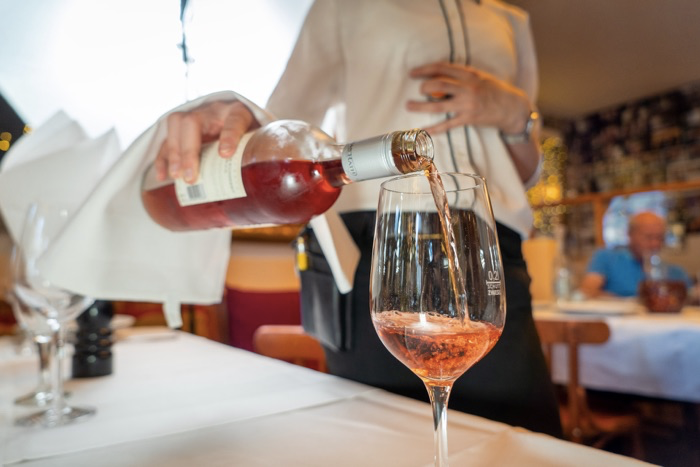Italian Rosé Wine: An Exquisite Blend of Tradition and Taste
Experience the romance of Italian Rosé wine - from fruity and refreshing to bold and complex, explore the diverse range of flavours Italy has to offer.

Italy is famous for its rich history, cultural heritage and delicious cuisine. When it comes to wine, Italy has carved out a special place for itself as one of the world's leading producers. Among its wide range of wines, Italian rosé stands out as a delicious blend of tradition and flavour.
This exquisite wine occupies a unique position in the hearts of oenophiles around the world, capturing their attention with its delicate nuances and refreshing flavours.
In this article, we will explore the fascinating history behind Italian rosé wines, their production methods rooted in age-old traditions and why they continue to captivate wine enthusiasts around the world with their unrivalled charm.
What Makes Italian Rosé Wine Special?
Italian Rosé wine is unique and distinct, offering a delightful balance of flavours, aromas, and colours. Unlike other wines, which are typically made from a single grape variety, Rosé is an artful blend of red and white grape varieties.
This blending process gives winemakers the freedom to create an array of styles, from bone-dry to slightly sweet, catering to every discerning palate.

The delicate hues of Italian Rosé wine, ranging from pale pink to vibrant coral, are a testament to the craftsmanship and attention to detail that go into its creation. Each sip tells a story of tradition passed down through generations, combined with modern winemaking techniques, making Italian Rosé an extraordinary and sought-after beverage.
The Charming History of Italian Rosé Wine
Italian Rosé wine has a captivating history that traces back centuries. The ancient Romans were among the first to experiment with producing Rosé, often blending red and white grapes in amphoras to achieve the desired hue and taste.
Over time, this winemaking artistry spread across the Italian peninsula, with various regions adding their own flair to the production process.
During the Middle Ages, Italian monasteries and abbeys played a significant role in refining the techniques of Rosé winemaking. Their dedication to preserving the grapevines and perfecting the art of blending culminated in wines that were savoured by kings, queens, and nobility.
How Are Italian Rosé Wines Made?
Crafting Italian Rosé wine is an intricate dance of nature and nurture, respecting the grape's inherent qualities while accentuating its unique characteristics. Here's a step-by-step overview of the winemaking process:
1. Grape Selection
The journey begins in the vineyards, where skilled viticulturists hand-select the finest grape clusters. The choice of grape varieties, such as Sangiovese, Montepulciano, or Nebbiolo, contributes to the final blend's complexity.
2. Gentle Crushing and Maceration
The grapes undergo a gentle crushing process to extract the desired colour and flavour. The skins are left in contact with the juice for a brief maceration period, during which the winemakers carefully monitor the colour development.
3. Fermentation
The must (crushed grapes) is then transferred to stainless steel tanks, where fermentation occurs at controlled temperatures. This phase is critical in achieving the desired balance of sweetness and acidity.
4. Blending
One of the hallmarks of Italian Rosé wine is the art of blending. Master blenders meticulously combine various grape varieties and batches to achieve the perfect harmony of flavours.
5. Aging
Some Rosé wines may undergo a brief ageing period in oak barrels, imparting subtle nuances and additional depth to the final product.
6. Bottling
Once the winemakers are satisfied with the blend's characteristics, the wine is carefully bottled, ready to grace the tables of wine enthusiasts around the world.
Famous Italian rosé wines regions
Italy's diverse terroirs offer an array of Rosé wines, each with its own personality and charm. Let's explore some of the notable regions known for producing exceptional Italian Rosé wine:
Veneto
Located in the northeast of Italy, Veneto is known for its production of high quality rosé wines that perfectly capture the essence of this vibrant region.
With its diverse landscape encompassing stunning mountains, picturesque lakes and an enchanting coastline along the Adriatic Sea, Veneto offers an ideal terroir for growing grapes with exceptional flavour profiles.
Veneto's winemakers pride themselves on crafting their rosé wines using traditional methods combined with modern techniques to create a unique tasting experience.
The region mainly grows indigenous grape varieties such as Corvina, Rondinella and Molinara to produce their distinctive rosés. These grapes are carefully harvested at just the right level of ripeness to ensure an optimal balance between acidity and sweetness.
Tuscany
Known for its robust reds, Tuscany has also made a name for itself in the production of exceptional rosé wines. The warm Mediterranean climate and diverse terroir of this region create the perfect conditions for growing grapes that result in refreshing and elegant rosés.
Tuscany offers a wide range of rosé options, made mainly from Sangiovese and other indigenous grape varieties such as Canaiolo and Colorino. These grapes provide vibrant acidity and distinctive flavours that make Tuscan rosés stand out.
With their pale pink tones, these wines often exhibit delicate aromas of fresh fruits such as strawberries, cherries and watermelon, along with hints of floral notes.
Lombardy
Lombardy, a region in northern Italy known for its picturesque lakes and vibrant cities, may not be the first place that comes to mind when thinking of Italian rosé wines. However, this hidden gem of a region offers some delicious surprises for wine enthusiasts looking for unique and refreshing rosés.
Lombardy's diverse terroirs and grape varieties make it an excellent destination for discovering exquisite rosé wines with their own distinctive character.
One of Lombardy's outstanding rosé wines is Chiaretto. Produced in the Lake Garda area, Chiaretto is made mainly from the indigenous grape variety Groppello. This delicate, pale pink wine exudes aromas of strawberries and cherries, with a fresh acidity that seduces the taste buds.
Puglia
Located in the southeastern part of Italy, Puglia is known for its warm climate, fertile soil and proximity to the Mediterranean Sea. These factors create an ideal environment for growing grapes that result in exquisite rosé wines.
Apulian rosé wines are predominantly made from indigenous grape varieties such as Negroamaro and Primitivo. The Negroamaro grape produces a rich body with flavours of red cherries and spices, while Primitivo offers vibrant acidity with notes of strawberries and raspberries.
Puglia's winemakers have mastered the art of blending these grapes to create harmonious rosé wines that exhibit elegance and complexity.
Abruzzo
Abruzzo, located in the heart of Italy, is famous for its exquisite rosé wines. With a rich winemaking history dating back centuries, this region has perfected the art of producing elegant and refreshing rosé wines that captivate wine lovers from around the world.
One of the key factors contributing to the exceptional quality of Abruzzo's rosé wines is its ideal climate and terroir. The region is blessed with a Mediterranean climate, characterised by hot summers and mild winters, which provides the perfect conditions for growing grapes.
The vineyards are nestled between mountains and coastal plains, benefiting from the cooling sea breezes that help maintain acidity levels in the grapes and create balanced flavours in the resulting wines.
Abruzzo has several indigenous grape varieties that are integral to its rosé production.
Sicily
Sicily, the largest island in the Mediterranean, has long been famous for its stunning scenery and rich cultural heritage. However, it is also home to a growing reputation for producing exceptional rosé wines.
Situated off the southern coast of Italy, Sicily's warm climate and diverse terroir create ideal conditions for growing grapes that produce vibrant, refreshing rosés.
Sicily's winemaking tradition dates back thousands of years, with evidence of Phoenician and Greek influence on viticulture practices.
Today, Sicilian winemakers combine these ancient techniques with modern innovations to produce a wide range of high quality rosé wines. The region boasts several indigenous grape varieties that bring unique flavours and aromas to its rosés.
Calabria
Calabria, Italy's southernmost region, may not be as well known for its wines as regions like Tuscany or Piedmont, but it is certainly a hidden gem when it comes to rosé wines.
Situated along the picturesque Tyrrhenian and Ionian coasts, Calabria benefits from a Mediterranean climate that provides ideal conditions for grape growing. With its rugged terrain and volcanic soil, this region produces unique and flavoursome rosé wines that are worth exploring.
One of the most distinctive characteristics of Calabrian rosé wines is their vibrant colour, ranging from delicate coral to deep salmon pink. This visual appeal is combined with an equally enticing aroma and flavour profile. Calabrian rosés often exhibit notes of ripe strawberries, juicy cherries and fragrant flowers.
Serving Tips
Whether you're hosting a summer gathering or simply enjoying a quiet evening at home, here are some expert tips on how to serve Italian rosé wines that will ensure an unforgettable drinking experience.
First of all, it is essential to serve rosé wines chilled but not too cold. The ideal temperature range is between 7°C-13°C. This allows the flavours and aromas of the wine to fully develop without being numbed by excessive cold.
Consider placing the bottle in the refrigerator for about two hours before serving or use an ice bucket filled with water and ice cubes to cool it gradually.
Next, choose the right glassware when serving Italian rosé wines. The glassware you use can greatly enhance the drinking experience. Opt for a tulip-shaped wine glass with a large bowl and a narrow rim. This shape helps to concentrate the aromas, allowing you to fully appreciate the nuances of the wine.

When it comes to serving Italian rosé wines, look for a moderate pour that fills about a third of the glass. This allows the wine to swirl and oxygenate properly, releasing its fragrances and enhancing its flavours. Moderate pouring ensures that the wine has enough room to swirl and interact with the oxygen in the glass.
This process, known as aeration, helps to open up the flavours and aromas of Italian rosé wines, allowing them to reach their full potential.
Perfect Pairings: Enjoying Italian Rosé Wine with Food
Italian Rosé wine's versatility shines when paired with various culinary delights. Its refreshing acidity and fruit-forward profile complement a wide range of dishes, making it an ideal choice for diverse occasions.
Antipasti Platter
Embrace the Italian tradition of starting a meal with an antipasti platter. Pair Rosé wine with cured meats, bruschetta, olives, and fresh mozzarella for a delightful explosion of flavours.

Seafood
The coastal regions of Italy beckon with abundant seafood options. Savor Rosé wine alongside grilled prawns, calamari, or a plate of linguine with clams for a match made in gastronomic heaven.
Light Pasta Dishes
Whether it's a plate of pasta primavera or a zesty pesto linguine, Italian Rosé wine harmonizes beautifully with lighter pasta dishes, adding a touch of elegance to every forkful.
Garden-Fresh Salads
For a refreshing al fresco experience, serve Rosé wine with a vibrant salad bursting with seasonal fruits and vegetables. The wine's crispness complements the salad's freshness, creating a delightful symphony of taste.
Conclusion
In conclusion, Italian rosé wine offers a delicious and refreshing option for wine lovers. With its vibrant colour, fruity flavours and fresh acidity, it is the perfect choice for those looking for a lighter, more versatile wine.
Whether enjoyed on its own or paired with a variety of dishes, Italian rosé wine is sure to please even the most discerning palates. So why not explore the world of Italian rosé wines today? Take a sip, savour the flavours and discover your new favourite summer wine - cheers!
You May Be Also Interested in









